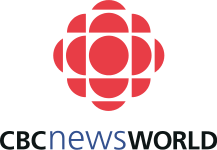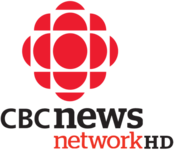CBC News Network
| CBC News Network | |
|---|---|
|
CBC News Network logo | |
| Launched | July 31, 1989 |
| Network | CBC News |
| Owned by | Canadian Broadcasting Corporation |
| Picture format |
1080i (HDTV) (2009-2011) 720p (HDTV) (2011-present) 480i (SDTV/16:9 Letterbox) (1989-present; has aired in 16:9 Letterbox since late 2011) |
| Slogan | The Number One News Network in Canada |
| Country | Canada |
| Broadcast area | National |
| Headquarters | Toronto, Ontario |
| Formerly called | CBC Newsworld (1989–2009) |
| Sister channel(s) |
CBC Television Ici Radio-Canada Télé Ici RDI Ici ARTV Ici Explora Documentary Channel CBC North |
| Website | CBC News Network |
Availability | |
| Satellite | |
| Bell TV |
Channel 502 (SD) Channel 1564 (HD) |
| Shaw Direct |
Channel 390 / 092 (SD) Channel 096 / 596 (HD) |
| Cable | |
| Available on most Canadian cable systems | Check local listings, channels may vary |
| IPTV | |
| Bell Aliant |
Channel 233 (SD) Channel 421(HD) |
| Bell Fibe TV |
Channel 502 (SD) Channel 1502 (HD) |
| MTS |
Channel 140 (SD) Channel 1140 (HD) |
| Optik TV |
Channel 9800 (SD) Channel 800 (HD) |
| SaskTel |
Channel 15 (SD) Channel 315 (HD) |
| VMedia | Channel 26 (HD) |
| Zazeen | Channel 49 (HD) |
CBC News Network (formerly CBC Newsworld) is a Canadian English-language news channel owned and operated by the Canadian Broadcasting Corporation (CBC). It broadcasts into over 10 million homes in Canada, and is a Category C specialty channel. It is the world's third-oldest television service of this nature, after CNN in the United States and Sky News in the United Kingdom.
CBC News Network's French-language counterpart is Ici RDI, also owned by the CBC.
Revenue
According to the Canadian Communications Monitoring report - Broadcasting system 2014, there are 11.3 million subscribers and revenue of $86.7 million. [1]
History
With CNN already being widely available in Canada during the 1980s, private and public Canadian broadcasters began to apply for a licence for a similar 24-hour news service in Canada. In 1987 the Canadian Radio-television and Telecommunications Commission (CRTC) awarded a licence to the CBC. Its launch was delayed several times: first when Allarcom, who had filed a competing application for an all-news channel, chose to appeal the CRTC decision;[2] second, when the federal cabinet issued a directive to the CBC to revise its service plan for the network to include private commercial broadcasters and to launch a parallel French language service;[3] and finally when cable companies were reluctant to add the service just five months after a similar launch of numerous other channels.[4]
CBC Newsworld began broadcasting on July 31, 1989 from several regional studios in Halifax, Toronto, Winnipeg and Calgary. However, budget cuts over the years forced the network to centralize most of its operations in Toronto and Calgary.
It is funded by cable subscriber fees and commercial advertising. Unlike the CBC's main television network, the channel cannot directly receive operational funds from the corporation's public funding allotment — although it does benefit from synergies with other CBC services, such as the ability to share reporters and programs with the main network.[5] In the 1990s, the channel also aired repeats of CBC Television's political sketch comedy series This Hour Has 22 Minutes and Royal Canadian Air Farce, but these were discontinued in 2001 after a CRTC directive that the shows did not qualify as news programming.[6]
While sometimes thought to be a mandatory basic cable channel, a number of cable systems, owned at the time by Persona, that did not carry CBC News Network at all during much of the 2000s. The channel was dropped by these systems in 2000 because of a fee dispute between Persona (then known as Regional Cablesystems; later acquired by Eastlink) and the CBC.[7]
Newsworld International
Some of CBC News Network's programming also aired on the now-defunct Newsworld International, a American cable news network co-owned by the CBC and the Power Corporation of Canada. CBC Newsworld (as it was then known) produced some programming for Newsworld International, and scheduled programming from other news networks like BBC World, which did not air on the Canadian channel.
Newsworld International was sold to USA Networks in 2000, then to Vivendi Universal in 2001. and then to Al Gore and Joel Hyatt in 2004. Newsworld continued to provide the network's programming until Gore and Hyatt launched their own network, Current TV, on August 1, 2005. In 2013, the channel was sold again to the Al Jazeera Media Network and became Al Jazeera America on August 20, 2013.
2009 re-launch
On October 21, 2009, it was announced that CBC Newsworld would be re-named CBC News Network on October 26 as part of a larger re-launch of the CBC News division. A new lineup of programs was introduced to the network, with a greater emphasis towards live news coverage. New programs included CBC News Now (the channel's rolling news coverage), Power & Politics, The Lang and O'Leary Exchange (a business news program hosted by Amanda Lang and investor of Dragons' Den fame Kevin O'Leary) and Connect with Mark Kelley.[8]
CBC News Network HD
In January 2009, the CBC launched an HD simulcast of CBC News Network (then known as CBC Newsworld) called CBC Newsworld HD. The channel was renamed CBC News Network HD on October 26, 2009 to coincide with the renaming of CBC Newsworld to CBC News Network. The HD feed has been confirmed at 720p resolution on Shaw cable after it was added to the lineup in 2014.
It is available through all major TV providers.
Programming
CBC News Network used to air a number of magazine-style programs, along with hourly news updates. The network has moved from that style of programming to focusing solely on live news programs and documentary programs, including The Passionate Eye and Rough Cuts, both of which used to be hosted by Michaëlle Jean, and Politics, a political affairs program which was hosted by Don Newman and aired twice daily. The Hour with George Stroumboulopoulos was launched in 2005 in an attempt to attract younger viewers; similar news-oriented talk shows, such as Pamela Wallin Live, CounterSpin, Face Off and Benmergui Live, also aired on the network in the 1990s.
The network's daytime schedule consists of the rolling newscast CBC News Now, which airs from 6 a.m. to 5 p.m. on weekdays and 7 a.m. to 5 p.m. on weekends. Instead of producing a separate morning news or noon-hour program, most CBC Television stations simulcast CBC News Now from 6 to 7 a.m. and 12 to 1 p.m. local time.
Power & Politics airs from 5 to 7 p.m., followed by the business news program The Exchange from 7 to 8 p.m. An evening edition of CBC News Now, anchored by Ian Hanomansing, airs at 8 p.m., and a simulcast of the Atlantic Canadian edition of The National airs from 9 to 10 p.m. From 10 p.m. until the first edition of CBC News Now the following morning, the schedule consists of repeat airings of CBC news and documentary programs.
Anchors
Current
- Peter Armstrong (The Exchange)
- Rosemary Barton (Power & Politics)
- Jennifer Hall
- Ian Hanomansing
- Heather Hiscox
- Colleen Jones
- Carole MacNeil
- Suhana Meharchand
- Reshmi Nair
- Andrew Nichols
- Scott Peterson
- Michael Serapio
Past
- Dave Brindle
- Kim Brunhuber - now with The National
- Bill Cameron - deceased (2005)
- Harry Forestell - now host of CBC News: New Brunswick
- Dawna Friesen - now with Global National
- Tom Harrington
- Michaëlle Jean - now former Governor General of Canada
- Mark Kelley[9]
- Nil Köksal - now CBC Toronto Weekend Host
- Amanda Lang
- Anne-Marie Mediwake (fall 2009)[10]
- Jordi Morgan - current Progressive Conservative Party of Nova Scotia metro organiser
- Don Newman - retired
- Anne Petrie
- Kathleen Petty - current Ottawa Morning host on CBC Radio Ottawa
- Lorne Saxberg - died in snorkeling accident in Thailand
- Sarika Sehgal
- Alison Smith - current co-anchor with Bernie McNamee of CBC Radio One's The World at Six
- Evan Solomon
- George Stroumboulopoulos - current the host of George Stroumboulopoulos Tonight on CBC Television
- Sheldon Turcott
- Nancy Wilson
Logos
 Current HD logo. Seen only in channel lineups
Current HD logo. Seen only in channel lineups Logo used by CBC Newsworld from 2001-2009
Logo used by CBC Newsworld from 2001-2009 Logo used from October 2009-March 2016
Logo used from October 2009-March 2016 HD Logo used from October 2009-March 2016
HD Logo used from October 2009-March 2016
References
- ↑ http://www.crtc.gc.ca/eng/publications/reports/policymonitoring/2014/cmr4.htm
- ↑ "Allarcom asks cabinet to overturn ruling giving licence to CBC for all-news channel". Ottawa Citizen, December 23, 1987.
- ↑ "CBC being sent back to drawing board over all-news plan". The Globe and Mail, January 27, 1988.
- ↑ "CBC all-news network launch put off to August from February". The Globe and Mail, December 23, 1988.
- ↑ Decision CRTC 2000-3, CBC News Network's 2000 CRTC licence renewal
- ↑ "Broadcasters can't have it both ways". National Post, July 9, 2001.
- ↑ Newsworld disappears from rural cable, CBC Saskatchewan, September 26, 2000
- ↑ CBC News (2009-10-21). "Changes to The National as CBC unveils new look". cbc.ca. Retrieved 2009-10-21.
- ↑ "Major changes ahead at CBC News". The Globe and Mail, Print Edition: June 16, 2009, Page R1.
- ↑ "CBC rebrands all-news network as CBC NN". Toronto Star, October 21, 2009.
